Protestantism by country
There are between 800 million and 1 billion Protestants worldwide,[1][2][3][4][5][6][7][8][lower-alpha 1] among approximately 2.5 billion Christians.[10][1][11][12][lower-alpha 2] In 2010, a total of more than 800 million included 300 million in Sub-Saharan Africa, 260 million in the Americas, 140 million in Asia-Pacific region, 100 million in Europe and 2 million in Middle East-North Africa.[2] Protestants account for nearly forty percent of Christians worldwide and more than one tenth of the total human population.[2] Various estimates put the percentage of Protestants in relation to the total number of the world's Christians at 33%,[5] 36%,[13] 36.7%,[2] and 40%,[3] while in relation to the world's population at 11.6%[2] and 13%.[8]
.svg.png)
| Part of a series on |
| Protestantism |
|---|
 |
|
Major branches |
|
Minor branches |
|
Broad-based movements |
|
Related movements |
|
|
| Christianity by country |
|---|
 |
|
|
|
|
Oceania
|
|
South America
|
|
|
In European countries which were most profoundly influenced by the Reformation, Protestantism still remains the most practiced religion.[5] These include the Nordic countries and the United Kingdom.[5][14] In other historical Protestant strongholds such as Germany, the Netherlands, Switzerland, Latvia, Estonia and Hungary, it remains one of the most popular religions.[15] Although Czech Republic was the site of one of the most significant pre-reformation movements,[16] there are only few Protestant adherents;[17][18] mainly due to historical reasons like persecution of Protestants by the Catholic Habsburgs,[19] restrictions during the Communist rule, and also the ongoing secularization.[16] Over the last several decades, religious practice has been declining as secularization has increased.[5][20] According to a 2012 study about religiosity in the European Union (EU) by Eurobarometer, Protestants made up 12% of the EU population.[21] According to Pew Research Center, Protestants constituted nearly one fifth (or 17.8%) of the continent's Christian population in 2010.[2] Clarke and Beyer estimate that Protestants constituted 15% of all Europeans in 2009, while Noll claims that less than 12% of them lived in Europe in 2010.[5][7]
Changes in worldwide Protestantism over the last century have been significant.[3][7][22] Since 1900, Protestantism has spread rapidly in Africa, Asia, Oceania and South America.[23][8][22] That caused Protestantism to be called a primarily non-Western religion.[7][22] Much of the growth has occurred after World War II, when decolonization of Africa and abolition of various restrictions against Protestants in Latin American countries occurred.[8] According to one source, Protestants constituted respectively 2.5% of South Americans, 2% of Africans, and 0.5% of Asians in 1900.[8] In 2000, percentage of Protestants on mentioned continents was 17%, more than 27% and 5.5%, respectively.[8] According to Mark A. Noll, 79% of Anglicans lived in the United Kingdom in 1910, while most of the remainder was found in the United States and across the British Commonwealth.[7] By 2010, 59% of Anglicans were found in Africa.[7] China is home to the world's largest Protestant minority.[2][lower-alpha 3]
Protestantism is growing in Africa,[23][24][25] Asia,[23][25][26] Latin America,[25][27] and Oceania,[23][22] while remaining stable or declining in Anglo America[22] and Europe,[5][28] with some exceptions such as France,[29] where it was legally eradicated after the abolition of the Edict of Nantes by the Edict of Fontainebleau and the following persecution of Huguenots, but now is claimed to be stable in number or even growing slightly.[29] According to some, Russia is another country to see Protestant growth.[30][31][32]
In 2010, the largest Protestant denominational families were historically Pentecostal denominations (10.8%), Anglican (10.6%), Lutheran (9.7%), Baptist (9%), United and uniting churches (unions of different denominations) (7.2%), Presbyterian or Reformed (7%), Methodist (3.4%), Adventist (2.7%), Congregationalist (0.5%), Brethren (0.5%), The Salvation Army (0.3%) and Moravian (0.1%). Other denominations accounted for 38.2% of Protestants.[2]
The United States is home to approximately 20% of Protestants.[2] According to a 2019 study, Protestant share of U.S. population dropped to 43%, further ending its status as religion of the majority.[33][34][35] The decline is attributed mainly to the dropping membership of the Mainline Protestant churches,[34][36] while Evangelical Protestant and Black churches are relatively stable or continue to grow.[34]
According to Scientific Elite: Nobel Laureates in the United States, a review of American Nobel prizes winners awarded between 1901 and 1972 by Harriet Zuckerman, 72% of American Nobel Prize Laureates came from Protestant backgrounds.[37] Overall, Protestants have won a total of 84.2% of all the American Nobel Prizes in Chemistry,[37] 60% in Medicine,[37] 58.6% in Physics,[37] between 1901 and 1972.
By 2050, Protestantism is projected to rise to slightly more than half of the world's total Christian population.[38][lower-alpha 4] According to other experts such as Hans J. Hillerbrand, Protestants will be as numerous as Catholics.[39]
According to Mark Jürgensmeyer of the University of California, popular Protestantism[lower-alpha 5] is the most dynamic religious movement in the contemporary world, alongside the resurgent Islam.[40]
Methodology
For the purposes of this list, the following Christian branches are considered Protestant:
- Adventists
- Anabaptists (including Amish, Hutterites, Mennonites)
- Anglicans (including Episcopalians)
- Baptists
- Calvinists (or the Reformed tradition) (including Congregationalists, Presbyterians, Continental Reformed, Waldensians)
- Lutherans
- Methodists
- Pentecostals
- Other Protestants (including Hussites, Brethren, Free Evangelicals, Quakers, United, Holiness and others)
Evangelicals, Charismatics, Neo-charismatics and other revivalists are found virtually across every Protestant branch. Nondenominationals, various independents and Protestants from other denominations, not easily fitting in the traditional classification, are also taken into account.
Estimates of total Protestant population vary considerably. Most reliable sources claim a range of 800 million to more than 1 billion. Difficulties occur as there is no consensus among scholars which denominations should be considered Protestant.
Countries
The seven regions considered in the following table are the six traditional ones (Europe, Asia, Africa, North America, South America, Oceania), plus Middle East (i.e. countries with Islamic majority from the Mediterranean to Iran).
| Region | Country | Total population (year) | % Protestant | Protestant total |
|---|---|---|---|---|
| Asia | 29,928,987 | 0.03% | 10,000 | |
| Europe | 3,563,112 | 0.23% | 8,191 | |
| Africa | 35,531,853 | 1.62% | 250,000 | |
| Europe | 71,201 | 2.1% | 1,495 | |
| Africa | 19,600,000 | 30.6% | 5,997,600 | |
| North America | 68,722 | 68% | 59,101 | |
| South America | 40,500,000 | 9% | 3,645,000 | |
| Europe | 2,982,904 | 3.7% | 110,368 | |
| Oceania | 23,401,892 (2016) | 23.1% | 6,355,952[41] | |
| Europe | 8,823,053 (2017) | 3.4% | 297,578[42] | |
| Europe | 8,581,400 | 0.07% | 6,007 | |
| North America | 353,658[43] | 70% | 247,561 | |
| Asia | 688,345 | ? | ? | |
| Asia | 144,319,628 | 0.23% | 331,935 | |
| North America | 278,289 | 67% | 186,454 | |
| Europe | 10,300,483 | 5% | 515,024 | |
| Europe | 10,364,388 | 1.35% | 140,000 | |
| North America | 279,457 | 30% | 83,837 | |
| Africa | 9,100,000 | 23% | 2,093,000 | |
| Asia | 2,232,291 | 0.018% | 400 | |
| South America | 8,857,870 | 16%[44]-17.2%[45]-20%[46] | 1,417,259 | |
| Europe | 4,025,476 | 0.04% | 1,610 | |
| Africa | 2,000,000 | 66% | 1,320,000 | |
| South America | 192,755,799 (2010) - 211,189,413 (2020)[47] | 22.2%-26%[44] | 42,791,786[48]- | |
| Asia | 372,361 | 1.3% | 4,841 | |
| Europe | 7,450,349 | 1% | 74,503 | |
| Africa | 17,000,000 | 9% | 1,360,000 | |
| Africa | 10,200,000 | 20% | 2,400,000 | |
| Asia | 13,607,069 | 0.04% | 5,390 | |
| Africa | 16,380,005 | 20% | 3,276,001 | |
| North America | 37,242,571 | 26% | 8,330,000[49] | |
| Africa | 415,294 | 3.5% | 14,535 | |
| Africa | 5,000,000 | 61% | 3,050,000 | |
| Africa | 11,500,000 | 18% | 2,070,000 | |
| South America | 18,192,000 | 13% - 15.5%[2] 11%[50] | 2,365,000 - 2.821.000 | |
| Asia | 1,382,710,000 (2016) | 2.9% | 39,970,000[51] | |
| South America | 46,900,000 (2011 est) | 12.5% | 5,862,500 | |
| Africa | 671,247 | 0.25% | 1,678 | |
| Africa | 4,100,000 | 51% | 2,091,000 | |
| Africa | 65,966,000 (2010) | 48% | 31,663,680[52] | |
| North America | 4,700,000 (2011 est) | 12.3%[53][54][55]-25%[56][44] | 1,250,000 | |
| Europe | 4,495,904 | 2% | 89,918 | |
| North America | 11,346,670 | 11% | 1,248,133 | |
| Europe | 780,133 | 2% | 15,603 | |
| Europe | 10,241,138 | 1.1% [57] | ||
| Africa | 22,500,000 | 23% | 5,175,000 | |
| Europe | 5,700,000 | 77% - 82% | 4,389,000 - 4,674,000 | |
| Africa | 900,000 | 0.2% | 1,800 | |
| North America | 69,278 | 15% | 10,392 | |
| North America | 10,000,000 (2011 est) | 18% (poll) | 1,800,000 | |
| Asia | 1,040,880 | 1.2%[58]-1.96%[59] | 31,226 | |
| South America | 14,700,000 | 12.5%-14%[60] | 1,837,500 | |
| Africa | 82,600,000 | 1% | 820,600 | |
| North America | 6,200,000 | 34.4% / 28% [61] | 2,132,800 | |
| Africa | 700,000 | 6% | 42,000 | |
| Africa | 5,900,000 | 5% | 295,000 | |
| Europe | 1,094,564 | 11% | 121,000 | |
| Africa | 73,750,932 (2007) | 18.6% | 13,717,673 | |
| Oceania | 893,354 | 42.5% | 379,676 | |
| Europe | 5,525,000 | 69.4%[62] | 3,834,000 | |
| Europe | 60,656,178 | 2% | 1,213,124 | |
| Africa | 1,500,000 | 39.7%[63] | ||
| Africa | 1,593,256 | 7% | 360,000 | |
| Europe | 4,677,401 | 2.14% | 100,000 | |
| Europe | 83,167,000 (2019) | 26.0% | 21,610,000[64] | |
| Africa | 24,200,000 (2010) | 58.1% | 14,060,200 | |
| Europe | 10,668,354 | 0.28% | 30,000 | |
| North America | 89,502 | 30% | 26,851 | |
| North America | 14,700,000 | 38.2% | 6,038,150 | |
| Africa | 10,200,000 | 4% | 408,000 | |
| Africa | 1,600,000 | 2% | 32,000 | |
| South America | 765,283 | 38% | 290,808 | |
| North America | 10,100,000 (2011 est) | 30% | 3,030,000 | |
| North America | 6,975,204 | 41% | 2,859,834 | |
| Europe | 10,006,835 | 14% | 1,401,640 | |
| Europe | 364,100 (2020) | 70.7% | 257,400[65] | |
| Asia | 1,352,642,280 (2018)[66][67] | At least 9,700,000[68] | ||
| Asia | 237,640,000 (2010) | 6.96% | 16,530,000[69] | |
| Asia | 68,017,860 | 0.3% | 204,054 | |
| Asia | 38,146,025 | 0.1% | 40,000 | |
| Europe | 4,761,900 (2016) | 4.2% | 201,400[70] | |
| Asia | 6,276,883 | 0.01% | 5,000 (mostly Anglican) | |
| Europe | 58,102,112 | 0.3%[71]-0.6%[72]-0.8%[73] | 755,328 | |
| North America | 2,731,832 | 60% | 1,639,099 | |
| Asia | 127,417,244 | 0.4% | 509,668 | |
| Asia | 5,759,732 | 0.5% | 28,799 | |
| Asia | 15,185,844 | 2% | 303,717 | |
| Africa | 40,513,000 (2010) | 47.4% | 19,203,162 | |
| Oceania | 103,500 | 40% | 41,400 | |
| Asia | 22,912,177 | 0.04% | 10,000 | |
| Asia | 48,422,644 | 18.1% | 8,760,000 | |
| Asia | 2,335,648 | 2.14% | 50,000 | |
| Asia | 5,146,281 | 0.03% | 1,337 | |
| Asia | 6,217,141 | 0.56% | 35,000 | |
| Europe | 2,070,371 | 35% | 714,000 | |
| Asia | 3,826,018 | 1% | 40,000 | |
| Africa | 2,200,000 | 50% | 1,100,000 | |
| Africa | 4,100,000 | 75% | 3,075,000 | |
| Asia | 6,765,563 | Less than 1% | ? | |
| Europe | 33,436 | 7% | 2,341 | |
| Europe | 3,596,617 | 1% | 35,966 | |
| Europe | 468,571 | 1% | 4,686 | |
| Africa | 21,300,000 | 38% | 8,094,000 | |
| Africa | 15,900,000 | 55% | 8,745,000 | |
| Asia | 28,900,000 | 4% | ||
| Asia | 349,106 | 0 | 0 | |
| Africa | 15,400,000 | 1% | 154,000 | |
| Oceania | 62,000 | 76.7% | 47,554 | |
| Africa | 3,500,000 | 0.1% | 3,500 | |
| Africa | 1,230,602 | 4.5% | 55,377 | |
| North America | 114,800,000 (2011 est) | 5%-10% [74] | 5,700,000-11,400,000 | |
| Europe | 4,455,421 | 0.26% | 11,634 | |
| Oceania | 108,155 | 47% | 50,833 | |
| Asia | 2,791,272 | 1.25% | 35,000 | |
| Africa | 32,725,847 | Protestant minorities | ? | |
| Africa | 23,100,000 | 27% | 6,237,000 | |
| Asia | 42,909,464 | 3% | 1,287,284 | |
| Africa | 2,300,000 | 74% | 1,702,000 | |
| Oceania | 13,048 | 66% | 8,612 | |
| Asia | 27,676,547 | 0.01 | 3,979 | |
| Europe | 16,407,491 | 11% | 3,445,573 | |
| Oceania | 4,699,755 | 26.7%[75] | 1,253,742 | |
| North America | 5,900,000 (2011 est) | 26.5% (PF) | 1,563,500 | |
| Africa | 16,100,000 | 0.5% | 80,500 | |
| Africa | 200,000,000 | 37.7% | 60,118,563[76]-75,400,000 | |
| Europe | 2,045,262 | 3% | 61,358 | |
| Europe | 5,328,000 | 73.2% | 3,900,000[77][78] | |
| Asia | 3,001,583 | N/A | N/A | |
| Asia | 162,419,946 | 0.86% | 1,400,000 | |
| North America | 3,600,000 | 24% | 864,000 | |
| Oceania | 5,545,268 | 61.5% | 3,410,340 | |
| South America | 6,600,000 | 6% | 396,000 | |
| South America | 29,400,000 (2011 est) | 12.5% (2006 census) | 3,675,000 | |
| Asia | 100,000,000 | 10.0%-8.2%[79] | 10,000,000 | |
| Europe | 38,635,144 | 0.2%[80] | 130,000 | |
| Europe | 10,566,212 | 0.4%[81][82] | 348,685 | |
| North America | 3,500,000 | 15% | 500,000 | |
| Asia | 863,051 | 1% | Unknown | |
| Europe | 22,329,977 | 6% | 1,339,799 | |
| Asia | 143,420,309 | 0.29% | 400,000 | |
| Africa | 10,900,000 | 43% | 4,687,000 | |
| North America | 38,958 | 74% | 29,335 | |
| North America | 166,312 | 10% | 16,631 | |
| North America | 117,534 | 77% | 90,501 | |
| Oceania | 179,000 | 49.8% | 89,142 | |
| Asia | 26,417,599 | 3.33% | 800,000 | |
| Africa | 11,126,832 | 0.5% | 55,634 | |
| Europe | 7,186,175 | 1.2% | 80,291 | |
| Africa | 81,188 | 8% | 6,495 | |
| Africa | 5,400,000 | 14% | 756,000 | |
| Asia | 4,425,720 | 8% | 354,058 | |
| Europe | 5,431,363 | 8.9 | 935,235 | |
| Europe | 2,011,070 | 0.8% | 16,135 | |
| Africa | 9,900,000 | 0 | 0 | |
| Africa | 50,500,000 (2010) | 72.9% | 36,814,500[52] | |
| Europe | 50,000,000 | 1%[52] | 500,000 | |
| Asia | 20,064,776 | 0.8% | 160,518 | |
| Africa | 44,600,000 | 5% | 2,200,000 | |
| South America | 500,000 | 25% | 125,000 | |
| Africa | 1,200,000 | 67% | 801,000 | |
| Europe | 10,000,000 | 60% | 6,000,000 | |
| Europe | 8,482,152 (2017) | 27%[83] | 2,290,000 | |
| Asia | 18,448,752 | 0.2% | 37,605 | |
| Asia | 22,894,384 | 2.6% | 595,254 | |
| Asia | 7,163,506 | 0.01% | 711 | |
| Africa | 46,200,000 | 27% | 12,474,000 | |
| Asia | 64,076,033 | 0.64% | 407,685 | |
| Africa | 5,681,519 | 9.5% | 539,744 | |
| Oceania | 112,422 | 73% | 82,068 | |
| North America | 1,300,000 | 38% | 494,000 | |
| Africa | 10,074,951 | 3.33% | 335,496 | |
| Asia | 69,660,559 | Less than 1% | 3,000 | |
| Asia | 4,952,081 | 0.6% | 81 | |
| Oceania | 11,636 | 94% | 11,450 | |
| Africa | 34,856,000 (2014) | 45.1% | 15,720,056 | |
| Europe | 47,425,336 | 2.3% | 900,000 | |
| Asia | 2,563,212 | 5% | 128,160 | |
| Europe | 63,181,775 (2010) | 16%-50%[84][85] | 10,000,000-32,000,000[86] | |
| North America | 330,000,000 | 46.5%[87] - 43% [88]- 36%[89] | 118,800,000 - 153,450,000 - 141,900,000 | |
| South America | 3,400,000 | 11% (2006 gov. survey) | 374,000 | |
| Asia | 26,851,195 | 0.01% | 1,345 | |
| Oceania | 243,304 | 40% | 97,321 | |
| Europe | 921 | 0% | 0 | |
| South America | 33,221,865 | 17%[90] | 5,647,717 | |
| Asia | 83,535,576 | 1% | 835,355 | |
| Asia | 20,727,063 | Approximately 1% | ? | |
| Africa | 13,500,000 | 68% | 9,180,000 | |
| Africa | 12,100,000 | 67% | 8,107,000 | |
| World | 7,600,000,000 (2017) | 12.1% | 920,000,000 | |
By region
The following are summary tables of the numbers and percentages of Protestants in each region. Also included are the percentages of Protestants in the world that reside in that region ("% of Protestant total").
| Region | Total Population | Protestants | % Protestant | % of Protestant total |
|---|---|---|---|---|
| Central Africa | 91,561,875 | 18,322,151 | 20.01% | 3.09% |
| East Africa | 225,488,566 | 36,965,728 | 16.39% | 6.23% |
| North Africa | 161,963,837 | 100,300 | 0.06% | 0.01% |
| Southern Africa | 137,092,019 | 55,432,677 | 40.44% | 9.35% |
| West Africa | 269,935,590 | 49,230,627 | 18.24% | 8.30% |
| Total | 886,041,887 | 160,051,482 | 18.06% | 26.99% |
| Region | Total Population | Protestants | % Protestant | % of Protestant total |
|---|---|---|---|---|
| Central Asia | 92,019,166 | 308,736 | 0.34% | 0.05% |
| East Asia | 1,527,960,261 | 25,550,708 | 1.67% | 4.31% |
| Middle East | 271,013,623 | 680,757 | 0.25% | 0.11% |
| South Asia | 1,437,326,682 | 9,458,283 | 0.66% | 1.59% |
| Southeast Asia | 571,337,070 | 26,387,155 | 4.62% | 4.45% |
| Total | 3,899,656,802 | 62,385,639 | 1.6% | 10.52% |
| Region | Total Population | Protestants | % Protestant | % of Protestant total |
|---|---|---|---|---|
| Central Europe | 82,033,047 | 7,803,177 | 9.51% | 1.32% |
| Eastern Europe | 209,198,166 | 1,389,452 | 0.66% | 0.23% |
| Northern Europe | 191,466,473 | 104,997,796 | 54.8% | 17.71% |
| Southeastern Europe | 65,407,609 | 1,713,080 | 2.62% | 0.31% |
| Southern Europe | 180,498,923 | 1,964,538 | 1.09% | 0.33% |
| Total | 728,604,218 | 117,868,043 | 16.2% | 19.90% |
| Region | Total Population | Protestants | % Protestant | % of Protestant total |
|---|---|---|---|---|
| Caribbean | 37,285,819 | 5,912,490 | 15.86% | 0.99% |
| Central America | 147,338,108 | 16,376,631 | 11.12% | 2.76% |
| North America | 328,539,175 | 172,167,236 | 52.4% | 29.03% |
| South America | 371,075,531 | 44,682,767 | 12.04% | 7.53% |
| Total | 884,238,633 | 239,139,124 | 27.05% | 40.32% |
| Region | Total Population | Protestants | % Protestant | % of Protestant total |
|---|---|---|---|---|
| Oceania | 30,809,781 | 13,474,012 | 43.73% | 2.27% |
Maps
Europe
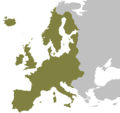 Approximate spread of Protestantism after the Reformation, and following the Counter-Reformation. Crypto-Protestants are not shown.
Approximate spread of Protestantism after the Reformation, and following the Counter-Reformation. Crypto-Protestants are not shown.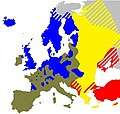 Approximate spread of Protestantism at the Reformation's peak. Crypto-Protestants, Crypto-papists, and Crypto-Muslims are not shown.
Approximate spread of Protestantism at the Reformation's peak. Crypto-Protestants, Crypto-papists, and Crypto-Muslims are not shown.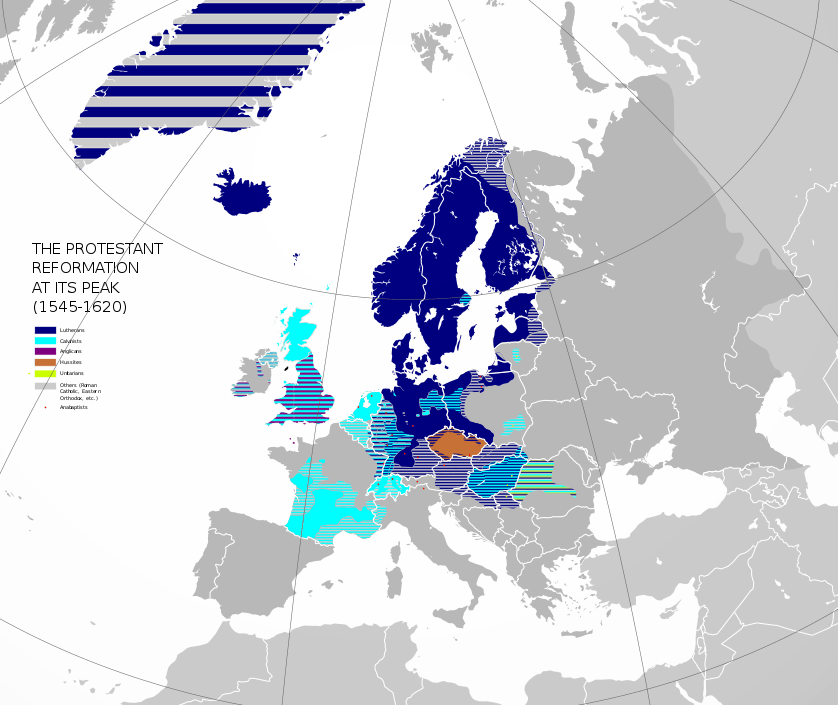 The Protestant Reformation at its peak.
The Protestant Reformation at its peak.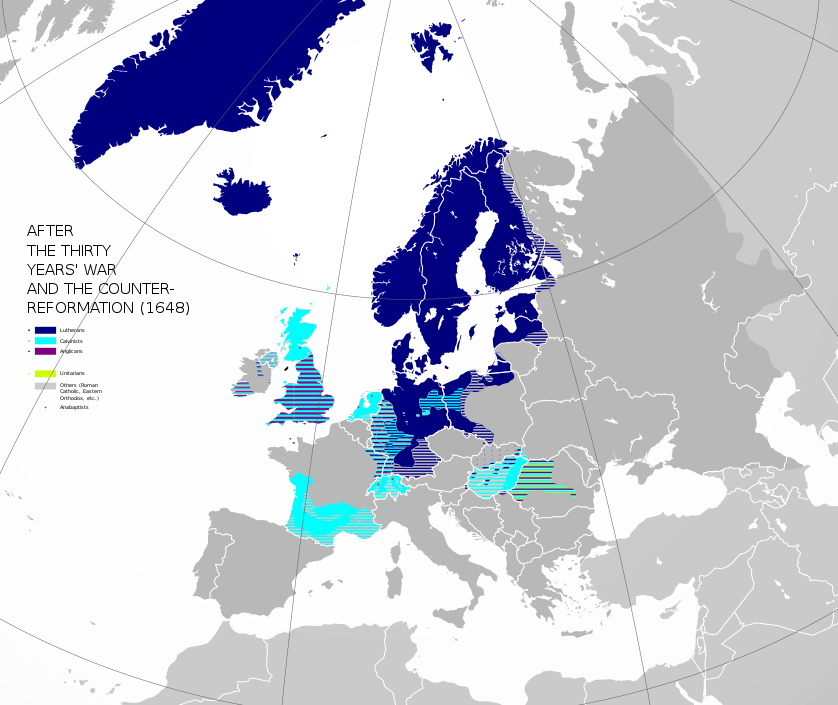 After the Counter-Reformation. Crypto-Protestants are not shown.
After the Counter-Reformation. Crypto-Protestants are not shown. After the Edict of Fontainebleau. Crypto-Protestants are not shown.
After the Edict of Fontainebleau. Crypto-Protestants are not shown.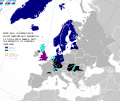 Modern spread after the Irish independence, Expulsion of Finns from Karelia and the Expulsions of Germans.
Modern spread after the Irish independence, Expulsion of Finns from Karelia and the Expulsions of Germans.
World
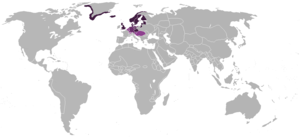 Countries by percentage of Protestants in 1545.
Countries by percentage of Protestants in 1545. Countries by percentage of Protestants in 1710.
Countries by percentage of Protestants in 1710. Countries by percentage of Protestants in 1938.
Countries by percentage of Protestants in 1938..svg.png) Countries by percentage of Protestants in 2010.
Countries by percentage of Protestants in 2010. Protestant majority countries in 1938.
Protestant majority countries in 1938..svg.png) Protestant majority countries in 2010.
Protestant majority countries in 2010.
See also
- Christianity by country
- List of Christian denominations by number of members
- List of the largest Protestant denominations
- Catholic Church by country
- Eastern Orthodoxy by country
- Oriental Orthodoxy by country
Other religions
Notes
- Most current estimates place the world's Protestant population in the range of 800 million to more than a billion. For example, author Hans Hillerbrand estimated a total Protestant population of 833,457,000 in 2004,[9] while a report by Gordon-Conwell Theological Seminary - 961,961,000 (with inclusion of independents as defined in this article) in mid-2015.[1]
- Current sources are in general agreement that Christians make up about 33% of the world's population—slightly over 2.4 billion adherents in mid-2015.
- Estimates for China vary in dozens of millions. Nevertheless, in comparison to the other countries, there is no disagreement that China has the most numerous Protestant minority.
- Protestant, Independent and Anglican parties are understood as Protestant as stated previously in the article, as well as in the book: Statistics for the P, I and A megablocs are often combined because they overlap so much-hence the order followed here.
- A flexible term; defined as all forms of Protestantism with the notable exception of the historical denominations deriving from the Protestant Reformation.
References
- "Christianity 2015: Religious Diversity and Personal Contact" (PDF). gordonconwell.edu. January 2015. Archived from the original (PDF) on 2017-05-25. Retrieved 2015-05-29.
- "Christian Traditions" (Web). Pew Research Center. December 19, 2011. Retrieved 2018-11-29.
- "Encyclopedia of Protestantism". Retrieved 14 February 2015.
- "CCC - Global Statistics". Retrieved 2015-12-05.
- "The World's Religions". Retrieved 14 February 2015.
- "Protestantism". Retrieved 14 February 2015.
- "Protestantism: A Very Short Introduction". Retrieved 14 February 2015.
- Jay Diamond, Larry. Plattner, Marc F. and Costopoulos, Philip J. World Religions and Democracy. 2005, page 119. link (saying "Not only do Protestants presently constitute 13 percent of the world's population—about 800 million people—but since 1900 Protestantism has spread rapidly in Africa, Asia, and Latin America.')
- Hillerbrand, Hans J. (August 2, 2004). "Encyclopedia of Protestantism: 4-volume Set". Routledge – via Google Books.
- 33.39% of 7.174 billion world population (as of 2014; under the section "People and Society") "World". CIA world facts.
- "Major Religions Ranked by Size". Adherents.com. Retrieved 2009-05-05.
- ANALYSIS (2011-12-19). "Global Christianity". Pewforum.org. Retrieved 2012-08-17.
- "Protestant Demographics and Fragmentations". Archived from the original on 18 March 2015. Retrieved 14 February 2015.
- "Religious Populations in England". Office for National Statistics. Retrieved April 8, 2011.
- "The Pearson General Knowledge Manual 2012". Retrieved 14 February 2015.
- "Protestantism in Bohemia and Moravia (Czech Republic) - Musée virtuel du Protestantisme". Retrieved 14 February 2015.
- "Tab 7.1 Population by religious belief and by municipality size groups" (PDF) (in Czech). Czso.cz. Retrieved 2013-11-19.
- "Tab 7.2 Population by religious belief and by regions" (PDF) (in Czech). Czso.cz. Retrieved 2013-11-19.
- "Frommer's Prague & the Best of the Czech Republic". Retrieved 14 February 2015.
- Lilla, Mark (31 March 2006). "Europe and the legend of secularization". The New York Times.
- "Discrimination in the EU in 2012" (PDF), Special Eurobarometer, 383, European Union: European Commission, p. 233, 2012, retrieved 14 August 2013
- "The Teachings of Modern Protestantism on Law, Politics, and Human Nature". Retrieved 14 February 2015.
- "Encyclopedia of Protestantism". Retrieved 14 February 2015.
- "Study: Christianity growth soars in Africa – USATODAY.com". USATODAY.COM. 20 December 2011. Retrieved 14 February 2015.
- Ostling, Richard N. (24 June 2001). "The Battle for Latin America's Soul". TIME.com. Retrieved 14 February 2015.
- "In China, Protestantism's Simplicity Yields More Converts Than Catholicism". International Business Times. 28 March 2012. Retrieved 14 February 2015.
- Arsenault, Chris (26 March 2012). "Evangelicals rise in Latin America". Al Jazeera. Retrieved 14 February 2015.
- "Religion in a Secularizing Society". Retrieved 14 February 2015.
- "Religious Newcomers and the Nation State". Retrieved 14 February 2015.
- "Moscow Church Spearheads Russia Revival". Retrieved 14 February 2015.
- "Protestantism in Postsoviet Russia: An Unacknowledged Triumph" (PDF).
- Felix Corley and Geraldine Fagan. ""Growing Protestants, Catholics Draw Ire"". ChristianityToday.com. Retrieved 14 February 2015.
- "In US, Decline of Christianity Continues at Rapid Pace," Pew Research Center, Oct. 17, 2019
- ""Nones" on the Rise: One-in-Five Adults Have No Religious Affiliation" (PDF).
- "BBC News - US Protestants no longer a majority - study". BBC News. 10 October 2012. Retrieved 14 February 2015.
- "Mainline Churches: The Real Reason for Decline". Retrieved 14 February 2015.
- Harriet Zuckerman, Scientific Elite: Nobel Laureates in the United States New York, The Free Pres, 1977, p.68: Protestants turn up among the American-reared laureates in slightly greater proportion to their numbers in the general population. Thus 72 percent of the seventy-one laureates but about two thirds of the American population were reared in one or another Protestant denomination-)
- Johnstone, Patrick, "The Future of the Global Church: History, Trends and Possibilities", p. 100, fig 4.10 & 4.11
- Hillerbrand, Hans J., "Encyclopedia of Protestantism: 4-volume Set", p. 1815, "Observers carefully comparing all these figures in the total context will have observed the even more startling finding that for the first itime ever in the history of Protestantism, Wider Protestants will by 2050 have become almost exactly as numerous as Roman Catholics - each with just over 1.5 billion followers, or 17 percent of the world, with Protestants growing considerably faster than Catholics each year."
- Juergensmeyer, Mark (November 3, 2005). "Religion in Global Civil Society". Oxford University Press – via Google Books.
- 2016 Census of Population and General Community (Sheet G14) Australian Bureau of Statistics
- "Zahlen & Fakten". Evang.at. 2018-02-16. Retrieved 2018-08-31.
- Bahamas Census 2010
- "Religion in Latin America". Pew Forum. Retrieved 2018-07-19.
- Religion affiliation in Bolivia as of 2018. Based on Latinobarómetro. Survey period: June 15 to August 2, 2018, 1,200 respondents.
- "El Papa Francisco y la Religión en Chile y América Latina" Latinobarómetro 1995-2017, Enero 2018
- "IBGE | Projeção da população". www.ibge.gov.br.
- "IBGE - Instituto Brasileiro de Geografia e Estatística (Brazilian Institute for Geography and Statistics) : 2010 Census" (PDF). Ftp.ibge.gov.br. Retrieved 16 November 2014.
- "Canada's Changing Religious Landscape". Pew Research Center. June 27, 2013.
- retrieved 8 Feb. 2018
- "中国到底有多少基督徒?——基于中国家庭追踪调查的估计". 察网. 2019-01-28. Retrieved 2020-05-02.
- "The Size and Distribution of the World's Christian Population". Pew Research Center. December 19, 2011.
- Klepeis, Alicia Z. (2019). Costa Rica. Bellwether Media. ISBN 9781618915887.
- Central Intelligence Agency (2019). The CIA World Factbook 2019-2020. Simon and Schuster. ISBN 9781510750470.
- "Costa Rica". The World Factbook-16%.
- Murillo, Alvaro (6 March 2018). "Ahora solo la mitad de los ticos se declara católica". Semanario Universidad. Retrieved 2 January 2019.
- CIA Factbook, 2015
- "Timor-Leste: Demographic and Health Survey, 2016" (PDF). General Directorate of Statistics, Ministry of Planning and Finance & Ministry of Health. p. 35. Retrieved 21 April 2018.
- "Nationality, Citizenship, and Religion". Government of Timor-Leste. 25 October 2015. Archived from the original on 14 July 2019. Retrieved 29 January 2020.
- "Latinobarómetro 1995 - 2017: El Papa Francisco y la Religión en Chile y América Latina" (PDF) (in Spanish). January 2018. Retrieved 5 September 2018.
- Latinobarometro Retrieved 8 February 2018
- Belonging to a religious community by age and sex, 2000-2019 Statistics Finland
- CIA World Factbook
- "Gezählt 2020 - Zahlen und Fakten zum kirchlichen Leben" (PDF). ekd.de. Retrieved 21 July 2020.
- "Populations by religious organizations 1998-2020". Reykjavík, Iceland: Statistics Iceland. Retrieved 14 April 2020.
- ""World Population prospects – Population division"". population.un.org. United Nations Department of Economic and Social Affairs, Population Division. Retrieved November 9, 2019.
- ""Overall total population" – World Population Prospects: The 2019 Revision" (xslx). population.un.org (custom data acquired via website). United Nations Department of Economic and Social Affairs, Population Division. Retrieved November 9, 2019.
- Melton, J. Gordon. "Encyclopedia of Protestantism". Infobase Publishing. pp. 284–285. Retrieved 16 November 2014.
- "Penduduk Menurut Wilayah dan Agama yang Dianut" [Population by Region and Religion]. Sensus Penduduk 2010. Jakarta, Indonesia: Badan Pusat Statistik. 15 May 2010. Retrieved 20 Nov 2011.
Religion is belief in Almighty God that must be possessed by every human being. Religion can be divided into Muslim, Christian, Catholic, Hindu, Buddhist, Hu Khong Chu, and Other Religion.
Muslim 207176162 (87.18%), Christian 16528513 (6.96), Catholic 6907873 (2.91), Hindu 4012116 (2.69), Buddhist 1703254 (0.72), Khong Hu Chu 117091 (0.05), Other 299617 (0.13), Not Stated 139582 (0.06), Not Asked 757118 (0.32), Total 237641326 - Census 2016 Summary Results April 2017, Central Statistics Office, Ireland
- "Itália tem apenas 0,3% de evangélicos no país | Primeira Igreja Batista de Campo Grande - PIBCG.Rio".
- "The Global Religious Landscape" (PDF). Pewforum.org. Retrieved 2 October 2015.
- "Missão Desafio | Itália". Missão Desafio.
- Latinobarometro retrieved 8 February 2018
- "2018 Census totals by topic – national highlights | Stats NZ". www.stats.govt.nz. Archived from the original on 2019-09-23. Retrieved 2020-01-05.
- "Table: Christian Population in Numbers by Country". Pew Research Center's Religion & Public Life Project. 19 December 2011. Retrieved 16 November 2014.
- Church of Norway Statistics Norway
- Members of Christian communities outside the Church of Norway Statistics Norway
- "East Asia/Southeast Asia :: Philippines — The World Factbook - Central Intelligence Agency". www.cia.gov.
- GUS. "Infographic - Religiousness of Polish inhabitiants". stat.gov.pl. Retrieved 2019-06-17.
- "Diminui número de evangélicos em Portugal, mesmo com surgimento de novas igrejas". Guiame. March 8, 2017.
- "Portugal | OM.org". www.om.org.
- Statistik, Bundesamt für. "Religionen". www.bfs.admin.ch (in German). Retrieved 2019-03-16.
- Gavin, Drake, "Survey reveals falling numbers," http://www.churchtimes.co.uk/articles2014-reveals-falling-numb
- Bradley, Ian (16 December 2017). "The strange death of Protestant Britain: the near-loss of religious sensibilities". The Tablet.
- Harriet Sherwood, "Church in crisis as only 2% of young adults identify as C of E," THE GUARDIAN, 2018/SEPT.,7. www.theguardian.com/world/2018/sep/07/church-in-crisis-as-only-2-of-young-adults-identify-as c-of-e
- "America's Changing Religious Landscape". Pew Research Center: Religion & Public Life. May 12, 2015.
- "In US, Decline of Christianity Continues at Rapid Pace, Pew Research Center, Oct. 17, 2019.
- "Protestants decline, more have no religion in a sharply shifting religious landscape (POLL)". ABC News.
- "Archived copy" (PDF). Archived from the original (PDF) on 2015-09-24. Retrieved 2015-08-24.CS1 maint: archived copy as title (link) Religion in Venezuela (see pag 41-42)
| Wikimedia Commons has media related to Protestantism by country. |
| Wikimedia Commons has media related to Protestant distribution maps. |